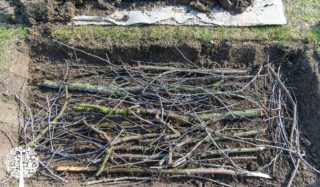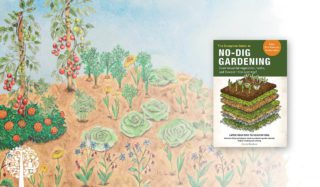
Before we learn how to build a hugelkultur garden, here are some of the benefits:
Making a hugelkultur garden bed is similar to making a lasagna; it involves a lot of layering.
First, select a site for the garden and be sure you won’t be moving it anytime soon. Remember, this bed is built to decompose over many years, up to 20, depending on the size you create. So you don’t want to be messing with it by changing locations.
Once you’ve chosen your spot, walk around your landscape and collect some dead logs, twigs, and branches. Hardwood (maple, ash, oak, birch) is recommended because it takes longer to break down than softwood, but fallen poplar trees will work well too.

Build a log pile anywhere between one and three feet tall. Make sure it’s nice and snug. You don’t want your garden to fall apart. Although hugelkultur is a no-dig method, some gardeners like to dig a trench to begin so the logs rest nicely at the bottom. If you’re using raised beds, there is no need to dig at all.
Once you’ve placed your logs and branches, cover them with a layer of nitrogen-rich material, like grass clippings, sod (upside down), compost, seaweed, or aged manure. You can add some garden soil too. These will help begin the decomposition process with the logs.
Cover the nitrogen layer with 6-12 inches of hay, straw, wood chips, or shredded leaves. This material will act as a mulch and help with water retention.
Surrounding the mound or garden bed with rocks or logs will keep the soil from washing away.
Now that you’ve created your garden, it’s time to start growing.
If you have layered the above materials in a deep raised garden bed, you can plant as usual and reap the benefits of the slow decomposition. Doing this will save you a ton of money; you won’t have to order as much earth or compost to fill the bed.
If you’ve created a hill or mound, remember that the top of the garden will be pretty dry, so plant crops that can tolerate arid conditions higher and thirsty crops toward the bottom of the hill.
Remember that although you have a layer of nitrogen-rich material in the garden, it takes time to decompose. So, in your first year of hugelkultur, you’ll likely need to add more compost than usual.
After year one, you won’t need to worry about this so much, but you’ll need to spread a thin layer of compost on the top before planting.

Happy Hugelkultur Gardening!
We love Charlie Nardozzi’s guide to hugelkultur gardening and no-dig techniques in general in The Complete Guide to No-Dig Gardening: Grow beautiful vegetables, herbs, and flowers – the easy way!